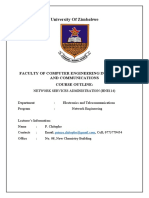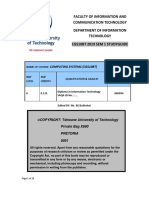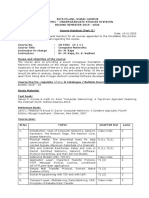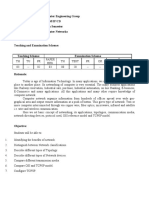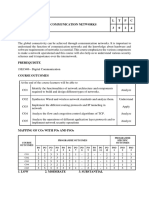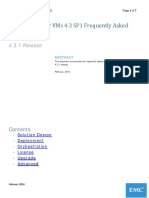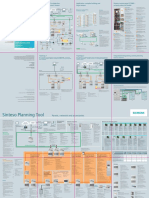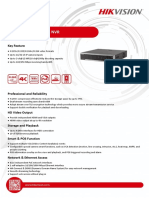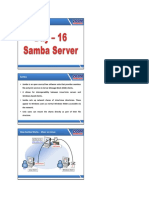Information Systems & Technology (IS&T)
Networking & Database (ISTN3ND)
STUDENT GUIDE - 2023
1. TITLE OF THE MODULE
Networking and Database Management
As per 2021 College Handbook, prerequisite requirements for ISTN3ND are: ISTN211 and
ISTN212, and (ISTN2IP or COMP200)
2. MODULE CODE
ISTN3ND
3. CREDIT VALUE OF THE MODULE
16 credit points
4. PREREQUISITES FOR THIS MODULE
ISTN211 and ISTN212
5. PURPOSE OF THE MODULE
To provide students with knowledge of the technical background of information systems in a
web and enterprise environment. To enable students to design and manage databases in a
business context. This module in part builds on Databases and programming ISTN212 and
other level 1 modules that prepares students for advanced database and network management
issues as well as further preparing them for their Major Project implementation.
6. LEARNING OUTCOMES
Students will be expected to:
Part A – Database Management
● Describe the steps and issues involved in the Database Design Life Cycle
● Identify and describe concurrency control problems and explain the methods for
implementing concurrency control
● Discuss the architecture, issues and complexities relating to setting up a distributed
database system
● Critically analyse the design and use of data warehouses
● Evaluate various web database connectivity options and describe the architecture of
internet databases
● Critically evaluate the issues involved in database administration
Part B - Networking
● Develop a clear understanding of the fundamental concepts of data communication such
as OSI and TCP/IP layered modelling and standards,
● Understand and value the essential role of Communication Protocols
● Understand the setup of enterprise networks and the various components of enterprise
networks
● Identify and describe the function of the various components of the Web Environment
● Understand how the Internet works; including the function of all the communication
2
� infrastructure within the Internet setup
● Identify Information Security aspects
7. LIST OF CONTENT TO BE COVERED
Part A -Topics include:
● Database Design (Ch 9)
● Transaction Management and Concurrency Control (Ch 10)
● Distributed Database Management Systems (Ch 12)
● Business Intelligence & Data Warehouses (Ch 13)
● Database Connectivity and Web Technologies (Ch 15)
● Database Administration & Security (Ch 16)
Part B - Topics include:
● Introduction to Data Communications; Network Standards & Protocols
● Fundamental Concepts
● Network architecture and infrastructure for Application Services
● Design of Enterprise wide network Infrastructure; including switches, routers, servers,
NOS, LAN, WAN, MAN, CAN, etc.
● The Internet, Web, Security, and various infrastructure components
The following chapters from the prescribed textbook (see section 12) would be covered;
Chapters 1 to 3
Chapters 5 to 8
8. TYPES OF DELIVERY, NOTIONAL STUDY HOURS & PEDAGOGY
8.1 Types of Delivery
The key approach to the module sees the lecturer as facilitating student’s acquisition of
skills, and theoretical constructs by using the material provided as well as being encouraged
to contribute to these resources from both their own reading and experiences. Peer
engagement is highly valued and students are encouraged to utilise existing online
communication and engagement tools to elicit this form of engagement, discussion and
application to enhance their acquisition of the taught knowledge.
Students will be expected to engage in the course content through the online module site,
Zoom / Teams sessions, chat sessions, emails and any other form of online engagement
methods.
8.2 Notional Study Hours
The anticipated number of hours that a student can expect to spend on this module is 160
notional study hours. The details is provided in the college handbook.
9. METHODS OF ASSESSMENT
The module follows a continuous assessment model where a number of assessments (may
include individual, group, assignments, discussions, participation etc.). A student’s final
module mark would be a combination of these various assessment modes.
3
�The final module mark is calculated using: (Equally split between Networking and Databases)
9.1 Details:
Section Weightings Percentage Contribution
Database Section (50%)
Exams – 30%
50%
Test – 15%
Quiz – 5%
Networking Section (50%)
Exams – 30%
50%
Test - 15%
Quiz – 5%
TOTAL (%) 100%
9.2 Assessment Dates:
Date Time Venue
Quizzes
- Networking 25th August 2023 TBC Online
- Databases 9th October 2023 (Moodle)
Test
- Networking 31st August 2023 3:00pm – 4:30pm TBC
- Databases 17th October 2023
Exams (Per exams timetable) (Per exams timetable) TBC
Test (Networking) = 50 marks = 60 minutes
Test (Database) = 50 marks = 60 minutes
Quiz (Networking) = 20 MCQs = 20 minutes
Quiz (Database) = 20 MCQs = 20 minutes
Exams (Networking & Databases) = 100marks = 180minutes
Scope :
- Tests and quizzes would cover the first four chapters of each section and related
uploaded learning/reference material
- Exams would cover all chapters in each section and all uploaded
learning/reference material
9.3 Aegrotat Tests
An aegrotat Test would be announced after all tests have been completed. Students
with legitimate reason as per the university rules (following the application for aegrotat
process) would be given permission to write the aegrotat for the missed test.
Students are encourage to write both test as missing any of the tests without legitimate
4
� reason would results in losing the associated mark for that test.
10. LECTURES & TUTORIALS
10.1 Face-to-Face Sessions
All face-to-face sessions would be in the respective lecture halls as prescribed by the
published university timetable.
10.2 Online Sessions (ONLY when face-to-face sessions become impossible)
When needed, Online sessions schedules would be communicated on Moodle before
sessions commences.
All online sessions on Zoom would be recorded on the zoom site. Zoom records all
sessions on its website and provides a link to access the recordings. These recordings
are kept by zoom for about 28days and then deleted.
Note: It is students’ responsibility to download and keep a copy of the Zoom recording
from the shared link be it is deleted by zoom. Lecturers are NOT responsible for keeping
copies of sessions nor their duration on Zoom!
10.3 Tutorials
Tutorial exercises would be uploaded onto the Moodle site for students to complete and
bring their solutions to the tutorial sessions for discussions. Students are to note that
ALL tutorials are exercises for students to complete before coming to the tutorial
session. Tutorial sessions are thus an engagement with students’ solutions and assist
students to better understand the topic covered and ability to answer related questions.
11. LECTURE MATERIALS
- Lecture slides and other supporting learning materials would be uploaded onto Moodle by
lecturers for student’s access.
- Students are responsible to engage with these materials and study at their own pace but
within the specified timeframe allocated for the module and topics (text chapters).
5
�12. LECTURERS
The lecturers involved in this module are:
Name Responsibility Email Address
Dr Ako-Nai Anyetei Lecturer - PMB akonaia@ukzn.ac.za
Mr Mpho Mzingelwa Lecturer -WST mzingelwa@ukzn.ac.za
12. PRESCRIBED & RECOMMENDED TEXTS
Business Data Communications by Jerry FitzGerald, Alan Dennis and Alexandra Durcikova.
13th Edition, John Wiley & Sons Inc. Publishers.
Databases: Coronel, C. and Morris, S., Database Systems: Design, Implementation and
Management, 13th Edition, Cengage Learning, 2019 - eBook Purchase Link
Other online resources will be prescribed and posted where necessary.
13. NOTICES
All notices relating to the module will be posted/delivered through Moodle.
Except in the case of weekends and holidays, a period of 24 hours will be regarded as sufficient
time for students to have acquainted themselves with any notice displayed here. Students are
also expected to check their email within a 24 hour period, as important information will also be
communicated through Moodle.
NOTE: After a period of 24 hours has elapsed (excluding weekends and public holidays) it will
be assumed that all students are familiar with the contents of published notices/emails.
---------------//---------------







